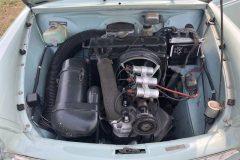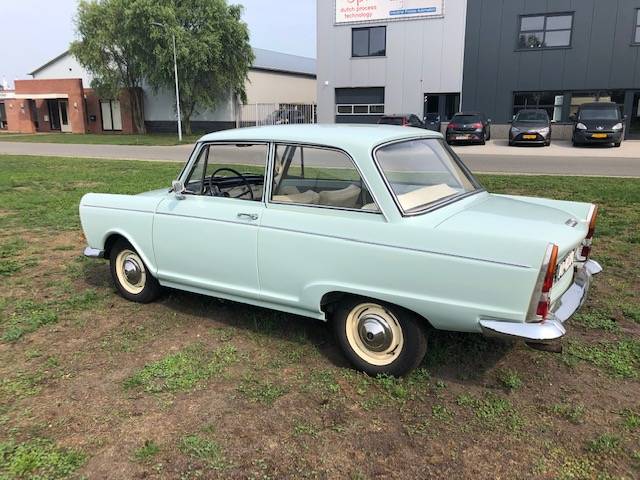Two-stroke are almost extinct. They are no longer made for modern cars and motorcycles. Despite all their benefits. But still: Honda has recently patented a two-stroke engine. Of course not such a simple piston-controlled two-stroke, but a thing with valves, pumps and - of course - electronics. But at the time, DKW made cars with two-stroke engines. Good cars with good engines. First they were two cylinders. Later three cylinders. DKW presented those two-stroke models as superior to the four-stroke engines of the competition.
And in Den Beginne there was the DKW Junior in 1957 with its 660 cc two-cylinder two-stroke, as was already known from DKW's Meisterklasse, which was put into 1953.
The DKW Junior was a small front-wheel drive sedan from Auto Union AG. During the press presentation, people responded positively to the car that was presented at 1957 in Frankfurt, the DKW 600, at the Frankfurt Motor Show in March 1957. The name 'Junior' was given to the engine that had grown to almost 750 cc when it went into production in 1959, died during an upgrade 1963, after which the car was known as the DKW F12. An open 'DKW F12 Roadster' was made next to the salon. But that did not happen in large quantities.
The DKW was known for its two-stroke engine. It was a three-cylinder and in connection with the two-stroke story, compared to its four-stroke variants, that three-cylinder was proudly presented as 3 = 6. A three-cylinder two-stroke was declared as high-quality as a six-cylinder four-stroke. A number of European car manufacturers already produced two-stroke powered cars in the 1950s, but by the time the DKW Junior hit the market, the two-stroke as a power source began to come under pressure. Two-stroke engines were seen by some as smoking and noisy, but that played less. The problem with the two-stroke was that more and more manufacturers started making good and cheap four-cylinder four-stroke. And two-stroke were thirsty. That also counted then.
The DKW F12 was built in a newly established factory in Ingolstadt.
And just as well the Junior, the later DKW F12, had a sleek modern line. With tail fins! Because resembling the big boys has never hurt anyone. The DKW still had a separate chassis. The three-cylinder engine from 741 cc delivered a healthy 35 hp and was a model of reliability. Its sound was unparalleled. Or to the taste of the accompanying "Very ugly!".
The later enlargement of the block to 796 cc did not make the sound much different
It also did not increase the specified capacity. But the enlarged three-cylinder engine produced more torque. And that's always good. The idea was that the DKW had to compete against the VW Beetle. And in that respect he had quite a few strong points. He had more luggage space and a more spacious interior. And with the optional heater on board, the temperature management from autumn became much better than that of the VW Beetle, where cooling air eventually had to do something about the cold. In order to make the heating work better in a Beetle, Volkswagen advised to open a door window ajar. Not to let the cold in, but to allow the - somewhat - heated air from the stove to circulate / ventilate better.
The definitive implementation of this DKW was from 1963 the DKW F12
It had a cylinder capacity of now 889 cc and delivered thick 40 hp. Much bigger news was that the DKW F12 was the first car in its class with disc brakes on the front wheels.
But the end of the two-stroke story was in sight. They had discovered the environment. And that had to be spared. A sensible idea in itself.
Early in the summer of 1965, Volkswagen took over the Auto Union company from Daimler Benz: production of the two-stroke DKWs was stopped almost immediately. On the market, the DKWs found it increasingly difficult to compete with more powerful four-stroke engines with similar dimensions from Volkswagen and more recently from Opel. Towards the end of 1965, the factory that was previously managed by Auto Union built cars with Audi badges, with four-cylinder four-stroke engines that were designed in collaboration with Mercedes Benz before the change of ownership. In the meantime, such a DKW is now quite rare. Many specimens, good specimens were given the death penalty unearned. Because: Dirty! A beautiful DKW F12, however, is a desirable classic that emits far fewer harmful substances than a Jumbo on a cheap flight to Crete. It is always just what you compare to.
So when Sander Buitink from Zelhem called with an audible grin and asked: “Guess what I have now!” The appointment was quickly made. Such a DKW F12 is an endearing, but serious and well-made time machine. And on secondary roads you can enjoy it while you attract a civilized view!








Hello I had such a dkw in the sixties I think it was in 68 but it has been years old watch me especially remember it is ahead of me that it was half automatic without clutch and with a steering gear so you could shift without clutching I have not had it for a long time would have preferred a car on clean petrol as it was then called TH
The sound of such a three-cylinder two-stroke is only messy when idle, idle. Once loaded and at a high speed, a machine like an electric motor runs so smoothly. And a two-stroke hangs wonderfully on the gas.
The death blow was the later DKW, the F-102. It had a 1200cc engine. A two-stroke with reverse flush is economical up to about 300 cc per cylinder, above that the flush is difficult to get and too much petrol vapor goes into the exhaust unburned. The car was nicknamed “Die drei vor der Tankstelle” after a famous comic film.
Incidentally, the largest engines in the world, the engines of large sea-going vessels, are all two-stroke. But then with inlet ports and outlet valves. The most efficient engine for constant speed.
Was the Junior not the F11 and later equipped with the larger engine and more luxuriously the F 12? Or do I remember that wrong?
The F 11 indeed became the F12. That had an 889cc 3cil 2 stroke engine with 45 hp
3 = 6 was only used with the F93 / 94 models and the KW 3 = 6 Monza
The extremely rare sports coupe that was built only 115 times in the period
1956/1958.
And the F91 then, does it not belong anymore ?????
Right